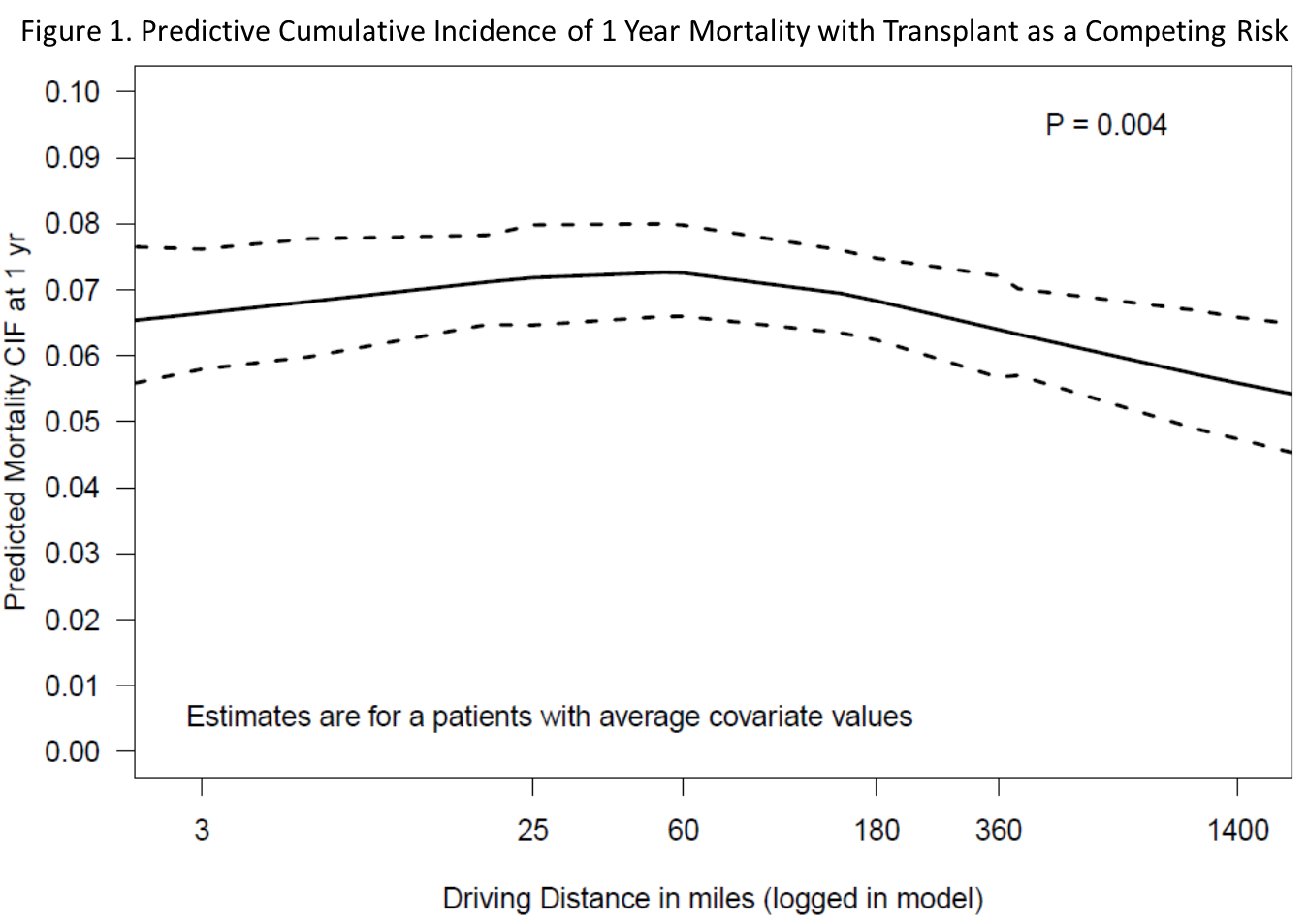Waitlisted for Lung Transplant and the Role of Patient Travel Distance: A National Cohort Study
Cleveland Clinic, Cleveland, OH
Meeting: 2019 American Transplant Congress
Abstract number: D174
Keywords: Lung, Lung transplantation
Session Information
Session Name: Poster Session D: Non-Organ Specific: Disparities to Outcome and Access to Healthcare
Session Type: Poster Session
Date: Tuesday, June 4, 2019
Session Time: 6:00pm-7:00pm
 Presentation Time: 6:00pm-7:00pm
Presentation Time: 6:00pm-7:00pm
Location: Hall C & D
*Purpose: Among patients waitlisted at the 75 lung transplant centers in the United States, the role of travel distance on waitlist outcomes is unknown. We measured travel burden by calculating the driving distance for each patient between household zip code and transplant center, and also assessed if patients bypassed the closest transplant center for care at a more distant location. We hypothesized that patient driving distance was not associated with the risk for death on the waitlist.
*Methods: Retrospective national cohort study of all adult waitlistings for lung transplant in the U.S. between January 1, 2006 through May 31, 2017 reported to the Scientific Registry of Transplant Recipients. Patients traveling from outside the U.S. for transplant were excluded. Using SAS URL access to GoogleMaps, driving distance was measured from the patient’s household zip code to the transplant center. Distance was categorized as <=60, >60-180, >180-360, and >360 miles. We also assessed if patients drove more than 60 miles and bypassed the nearest transplant center to be waitlisted at a more distant center. We estimated the cumulative incidence of waitlist death with transplant as a competing risk across driving distances, and also fitted adjusted competing risks regression models.
*Results: 22,958 patients met inclusion criteria. The median driving distance was 69.7 miles from household zip code to transplant center. 10,567 (46%) patients drove <=60 miles, 6,768 (29.5%) drove >60-180 miles, 3,472 (15.1%) drove >180-360 miles, and 2,151 (9.4%) drove >360 miles. Overall, 22.2% of patients drove more than 60 miles and bypassed the nearest center to be waitlisted at a more distant center. Among patients driving >60-180 miles, 17.3% bypassed the nearest center by more than 60 miles, among patients driving >180-360 miles 57.5% did, and among patients driving >360 miles 90.5% did. Patients with the furthest driving distance were significantly more likely to be male (62.0% vs 54.4% in <60) and have a higher lung allocation score (mean 43.5 vs 42.4 in <60). Longer driving distance was associated with slightly lower probability of death and this association was non-linear. Results remains significant after adjustments (p = 0.004, see figure 1).
*Conclusions: Longer driving distance for waitlisted patients was associated with slightly lower probability of death when accounting for transplant as a competing risk. Further research is needed into patient preferences when seeking transplant care, and the potential impact on patient travel burdens from the 2017 donor lung allocation policy change using broader geographic sharing.
To cite this abstract in AMA style:
Tsuang W, Arrigain S, Lopez R, Snair M, McCurry K, Budev M, Schold J. Waitlisted for Lung Transplant and the Role of Patient Travel Distance: A National Cohort Study [abstract]. Am J Transplant. 2019; 19 (suppl 3). https://atcmeetingabstracts.com/abstract/waitlisted-for-lung-transplant-and-the-role-of-patient-travel-distance-a-national-cohort-study/. Accessed December 13, 2025.« Back to 2019 American Transplant Congress

